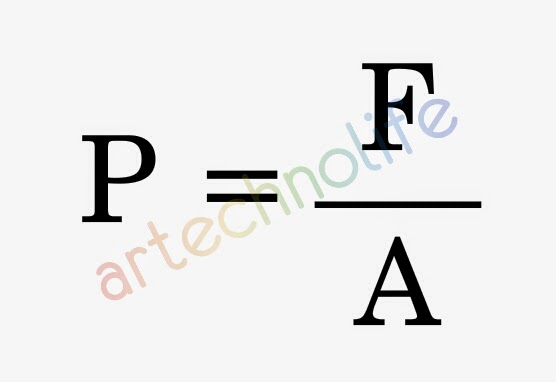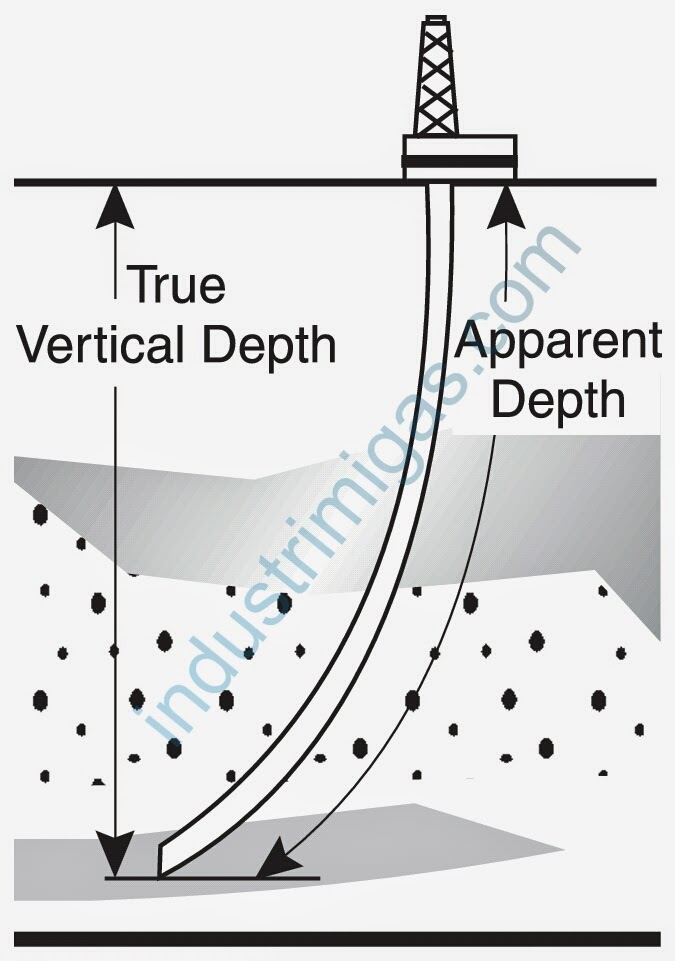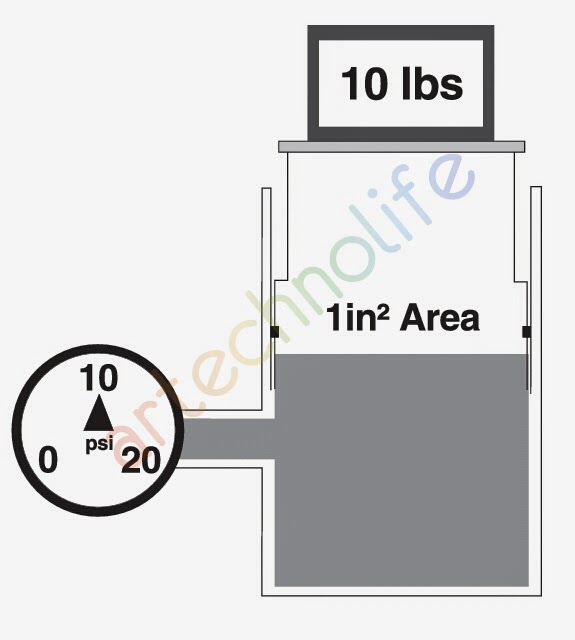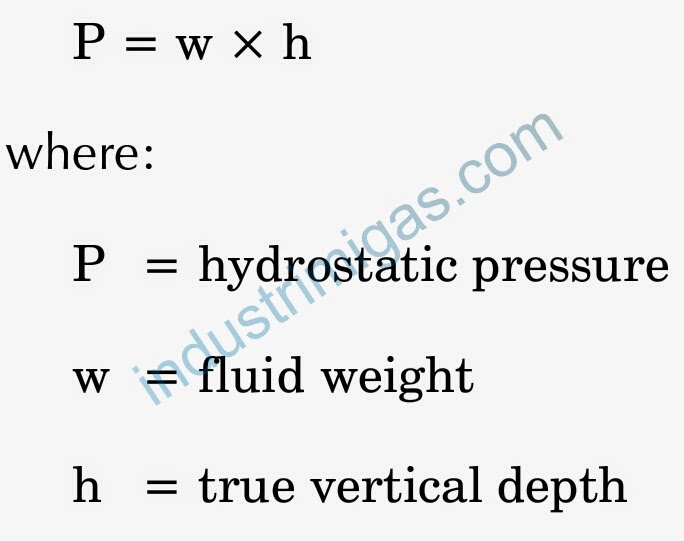Pressure Calculation for Oil Field Application
Definition of Pressure
[post_ad][full_width]
Pressure is defined as the force per unit area exerted on a surface. For example, a force of 10 pounds pushing on a surface with 1 square inch of area would exert a pressure of 10 pounds per square inch on that surface. Mathematically, pressure is expressed as:
where:
P = pressure (lb/in2)
F = force (lb)
A = surface area (in2)
It is important to remember that pressure exerts in all directions. On picture above illustrates the concept of pressure. The fluid below the piston exerts a uniform pressure of 10 psi on every surface, perpendicular to the surface planes. When solving oilfield problems, there are two types of pressure to consider: applied and hydrostatic pressure.
Applied pressure is due to a pump or similar means. Applied pressure is felt throughout the system equally. For example, applying 2,000 psi to the inside of a pipe exerts 2,000 psi everywhere on the pipe wall regardless of the pipe size. Applying 5,000 psi at the surface of a 10,000 ft well will exert 5,000 psi throughout the well bore.
Hydrostatic pressure is fluid pressure due to the weight of fluid above it. Both gases and liquids exert hydrostatic pressure. Hydrostatic pressure is present at all points below the surface of a fluid, but unlike applied pressure it is not constant. The hydrostatic pressure at any point depends on the fluid density and the depth below the fluid surface. A good example of hydrostatic pressure is atmospheric pressure. The weight of the air causes an average pressure of 14.7 psi at sea level. It is well known that as elevation above sea level increases, air pressure decreases.
[post_ad]
Oilfield problems usually involve finding pressures exerted on tubing, casing and downhole tools. In deviated wells (i.e., wells which are not vertical), finding the hydrostatic pressure requires the true vertical depth. For example, the apparent depth of a deviated well may be 10,000 ft, but the vertical depth may only be 7,500 ft. Hydrostatic pressure in a well depends only on true vertical depth.
In the previous section, hydrostatic pressure was said to depend on fluid density and depth. Fluid density is defined as mass per unit volume. Density is also expressed by specific gravity (γ). Specific gravity is a comparison to the density of water. For example, a fluid with a specific gravity of 1.5 will have a density 1.5 times that of water. The density of oil is often in API gravity (e.g., 38° API oil). In the American system, it is more common to specify the fluid weight rather than the fluid density since pounds are units of force. The units for fluid weight are lb/gal, lb/ft3 or lb/in3. To determine hydrostatic pressure, the following formula may be used:
P = pressure (lb/in2)
F = force (lb)
A = surface area (in2)
It is important to remember that pressure exerts in all directions. On picture above illustrates the concept of pressure. The fluid below the piston exerts a uniform pressure of 10 psi on every surface, perpendicular to the surface planes. When solving oilfield problems, there are two types of pressure to consider: applied and hydrostatic pressure.
Definition of Applied Pressure
Applied pressure is due to a pump or similar means. Applied pressure is felt throughout the system equally. For example, applying 2,000 psi to the inside of a pipe exerts 2,000 psi everywhere on the pipe wall regardless of the pipe size. Applying 5,000 psi at the surface of a 10,000 ft well will exert 5,000 psi throughout the well bore.
Definition of Hydrostatic Pressure
Hydrostatic pressure is fluid pressure due to the weight of fluid above it. Both gases and liquids exert hydrostatic pressure. Hydrostatic pressure is present at all points below the surface of a fluid, but unlike applied pressure it is not constant. The hydrostatic pressure at any point depends on the fluid density and the depth below the fluid surface. A good example of hydrostatic pressure is atmospheric pressure. The weight of the air causes an average pressure of 14.7 psi at sea level. It is well known that as elevation above sea level increases, air pressure decreases.
Oilfield problems usually involve finding pressures exerted on tubing, casing and downhole tools. In deviated wells (i.e., wells which are not vertical), finding the hydrostatic pressure requires the true vertical depth. For example, the apparent depth of a deviated well may be 10,000 ft, but the vertical depth may only be 7,500 ft. Hydrostatic pressure in a well depends only on true vertical depth.
Oilfield problems usually involve finding pressures exerted on tubing, casing and downhole tools. In deviated wells (i.e., wells which are not vertical), finding the hydrostatic pressure requires the true vertical depth.
Calculating Hydrostatic Pressure
In the previous section, hydrostatic pressure was said to depend on fluid density and depth. Fluid density is defined as mass per unit volume. Density is also expressed by specific gravity (γ). Specific gravity is a comparison to the density of water. For example, a fluid with a specific gravity of 1.5 will have a density 1.5 times that of water. The density of oil is often in API gravity (e.g., 38° API oil). In the American system, it is more common to specify the fluid weight rather than the fluid density since pounds are units of force. The units for fluid weight are lb/gal, lb/ft3 or lb/in3. To determine hydrostatic pressure, the following formula may be used:
Pressure Calculation for Oil Field Application
 Reviewed by Djoernalist
on
9:05 PM
Rating:
Reviewed by Djoernalist
on
9:05 PM
Rating:
 Reviewed by Djoernalist
on
9:05 PM
Rating:
Reviewed by Djoernalist
on
9:05 PM
Rating:









Hello, my name is Aisha Nayla, prey to fraud at the hands of fake lenders. I lost around Rp300,000,000 because I needed a large capital of Rp300,000,000,000. I almost died, I had no place to go. my trade was destroyed, and in the process I lost my child and mother. I can't stand this incident anymore. Last week I met an old friend who introduced me to a good mother, Mrs Christabel Missan Loan Investment Company, which finally helped me get loan of Rp500,000,000,000 loan
ReplyDeleteGood mother, I want to take this opportunity to express my gratitude, and may God continue to bless the good mother Christabel Missan and my friend. I also want to use this opportunity to give advice to fellow Indonesians, that there are a lot of fraudsters there, so if you need a peace and security loan and anyone who needs an urgent loan should be quick, contact Christabel Missan via email [email protected]
You can still contact the mother whatsApp number +15614916019
You can also contact me by email: ([email protected]). And you can still contact my friend who introduced me to a good mother loan company, Lady Liliyana, email: [email protected] if you are in doubt. help him the only person who can be trusted and can be trusted.